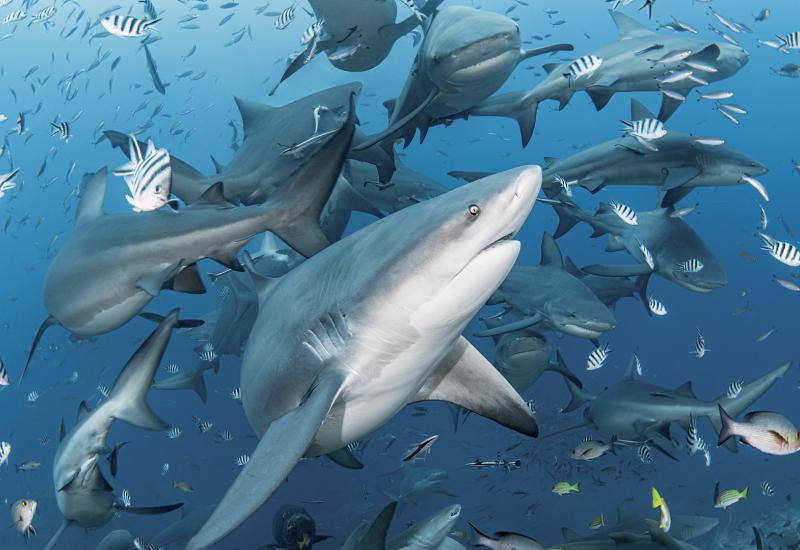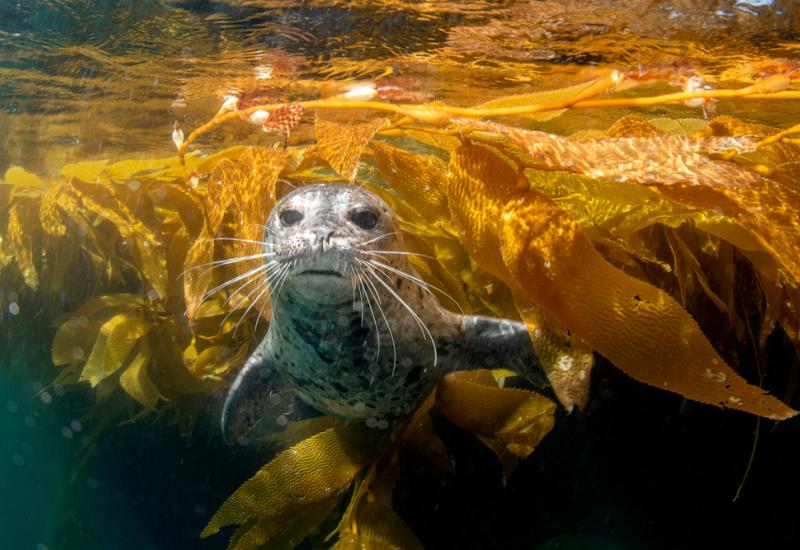South Africa

South Africa
Shutterstock
We'd been working the white sharks off Gansbaai, South Africa, for a couple of days and had some tantalizingly close encounters, but still hadn't nailed the definitive bite shot. I wanted jaws agape and jagged teeth exposed, an image of ferocity and power, the illustration of the iconic great white shark we all love and fear. This day we'd invited friends and family to watch the action from a second boat as our group of hard-core shark shooters tried to entice a great white within camera range.
We soon had a player, and it was my delusional strategy to lie on my belly on the swim platform with my camera half-in, half-out of the water while shark wrangler Andre Hartman lured the shark ever closer. With Andre straddling my prone form and reeling the bait toward the boat I kept chanting "closer, closer, closer." Andre kept chanting "watch your ass, watch your ass, watch your ass" as the shark followed and homed in on the bait.
My eye was pressed to the viewfinder and my camera's motor drive was racing when the shark suddenly filled the frame, open-mouthed. Then, bam! The shark's snout rammed my dome port, slamming the housing against my forehead. From all around me, I heard a collective "Are you OK?" But then a tiny voice from the other boat cut through the cacophony. My nine-year-old daughter wanted to know the truly important thing: "Daddy, did you get the shot?"
I did get the shot. But as with all photography of great white sharks, it took a combination of skill, luck and, maybe most importantly, proximity. A shark shooter has to go where white sharks are, and while they may range throughout the world, there are just three locations where dive operators reliably and safely put divers in proximity with Carcharodon carcharias: South Africa, South Australia and Guadalupe Island, Mexico.
In July 2003 I embarked on a great white photo expedition to South Africa.
Trip Log: Today I had a few magic passes while in the cage. When all the elements were perfectly aligned, I could get a shark close (anything farther than three feet away simply would not work in this turbid water), mouth open, and no bait in the frame. My digital LCD confirmed I had a hot series in the bank.
I shot my next sequence while sitting on the side of the cage as the shark shredded a tuna head not more than three feet away. The motor drive raced as the action peaked. Once the shark slid back in the water I realized the last few shots looked kind of blurry. I found my dome smeared in tuna blood and shreds of meat. Then, wiping my face, I found I was also drenched in blood and detritus. Fortunately, the blood wasn't mine, but being close enough to a feeding great white shark to wipe fish flesh off my face was the reason I'd come to South Africa!
South Africa appeared on our collective radar screens in the late 1990s as images began to filter back from Dyer Island, just off the fishing village of Gansbaai. Topside shots were particularly impressive. David Doubilet got the cover of National Geographic with a "jawing" shot, a killer vertical image looking straight down the cavernous maw of a great white. Meanwhile, in nearby False Bay, Chris Fallows was amazing photo editors and film crews with breaching whites. These white sharks actually launch themselves fully out of the water in pursuit of a seal decoy in a graphic demonstration of power.
One huge plus to the South Africa itinerary is that it can be done in conjunction with a wildlife safari in either South Africa or Botswana. This year we toured two of the finest safari camps in Botswana and then traveled overland from Capetown to Gansbaai. Once in Gansbaai, there are a number of bed-and-breakfasts that cater to the white shark set, or you can opt for more upscale accommodations at Grootbos Nature Preserve. Unlike South Australia and Gualalupe, which must be dived from a live-aboard boat, the white shark encounters from Dyer Island are done as day trips.
Because it's only about a 30-minute boat ride to Dyer Island from Gansbaai, this is the perfect opportunity for someone who wants to notch white sharks on their experiential dive belt but doesn't want to spend a week sleeping on a boat. In the season (late May through August), scores of day-trippers make the pilgrimage to Gansbaai, and many of the boats are devoted to this rather casual end of the trade. Others boats cater more exclusively to serious professional photographers and film crews, which can make for curious bedfellows as boats compete for the attention of whatever white sharks may be working that day. There can easily be a dozen boats on location, but when you have the attention of one particularly willing "player," none of that matters.
While South Africa can deliver both underwater and topside photo-ops with great whites, the water clarity is usually 15 to 20 feet, so it takes a very close encounter to create a high-quality image. The seas can be quite rough as well, so it can be uncomfortable inside the cage at times. But the sharks are here in abundance, and when properly motivated, they will approach quite closely.
South Africa great whites are best known for giving photographers the chance to capture "jawing" on film. This behavior was discovered by Andre Hartman and is now replicated by other local shark wranglers. A great white is lured to the back of the boat and then just as it opens its mouth for the bait, the wrangler places his fingers along the snout and pushes the shark into an upright position. Then, in a kind of immobile trance, the shark will pause momentarily on the surface with mouth open, sometimes long enough to let you burn 36 shots in a rapid motordrive sequence.
South Africa: The Scoop
The Good: Lots of sharks, skilled operators able to deliver compelling shark action. Possible to do as a day trip.
The Bad: Lots of boats and competition for the sharks, plus potential for bad weather anytime of year.
The Ugly: Sitting on a boat under perfect conditions with absolutely no shark action, while just 15 yards away another shooter has an aggressive shark that comes repeatedly to pose for him. Been there, done that. I did not have fun that day.
Dive In
Travel Savvy: South Africa has a population of whites off Dyer Island all year, but in its summer the visibility is very bad due to plankton blooms. Plan your trip to South Africa from mid-June through early August.
Weather: Visibility ranges from 10 to 30 feet, and water temperature is usually in the mid-60s. Surface conditions vary from slick calm to very rough. White sharking is hard to do in more than a four-foot sea, so on very rough days the boats tend to stay home.
Destination Links: In South Africa, contact Marine Dynamics, www.dive.co.za.










